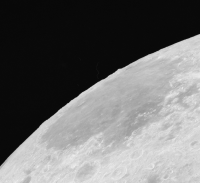
| Project Home | About the Scans | Browse Gallery | Image Map | Support Data | Resources | Ephemeris |
Featured Image - 07/20/2010
Departure Views of the Moon
As the Apollo 16 astronauts headed back to Earth, the service module was oriented so that the Metric camera was still able to image the Moon (Figure 1). From this vantage point, parts of the Moon can be seen that are not visible from Earth. In the upper left corner of the image, you can see Mare Crisium on the near-side. The rest of the Moon in the image is not visible from Earth.
Looking at this image, you can easily see the effect of incidence angle (which is the angle between the sun and a plane normal to the surface of the body of interest) on how the images look. Where the incidence angle is very high (as in the upper left portion of the image), the differences in albedo between the mare and surrounding terrain shows up very well. The incidence angle is decreasing toward the lower right of the image and as it decreases, topography becomes more and more readily discerned. See the ASU Apollo Featured Image for August 5, 2008 to view the effect incidence angle on apparent surface roughness.
Figure 1. Figure 1: Full view of the Moon as seen from the AS16 Metric camera mounted on the Lunar Service Module, Casper. The red dashed line represents the eastern limit of the Moon visible from Earth. The box in the upper left outlines the boundary for Figure 2. (Apollo Image AS16-M-3024 [NASA/JSC/Arizona State University])
One of the more interesting attributes of being able to see the full lunar disk is the topography visible along the edges (Figure 2).

Figure 2. Note the mountains of the Moon visible, along the lunar limb near Mare Crisium.
Tweet
|
|
Space Exploration Resources |
|
 LPI LPI
|
